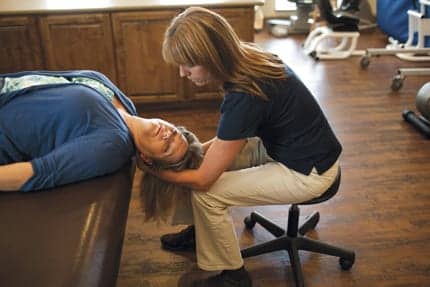by Christie Schoel, PT, CBIS

The visual, skeletal, and vestibular systems interact to maintain a sense of where the body is when resting or moving. It also provides visual clarity of objects during head movement. These systems act together in a way that allows individuals to perform such routine activities as track a bird across the sky, hold an object in sight, or multitask among the systems, such as reading GPS instructions on a cell phone while walking down a sidewalk. The most common symptoms of a disorder with the vestibular system include vertigo, dizziness, imbalance, nausea, and vomiting. Other symptoms can include anxiety, panic, disorientation, and depression, to name just a few. Vestibular disorder is fairly common, especially among older adults, and can be brought on by a variety of causes, including disease, infection, or injury.
For survivors of an acquired brain injury (ABI), vestibular disorder can compound symptoms that arise from the injury. Moreover, secondary symptoms—or symptoms that arise as a result of the body trying to adjust and cope with the condition—can be equally debilitating but in different ways. These frequently include weakness, loss of range of motion, and increased muscle tension, especially in the back and shoulders, which can give rise to muscle fatigue and even headaches. These, too, can affect a person’s ability to change positions or move about without imbalance and vertigo. And, over time, they may compel a patient to radically limit physical movement and not keep up with basic necessities, such as eating and grooming.
Vestibular rehabilitation therapy (VRT) is a specialized form of therapy that uses exercises to help improve balance, gait, and vision. It does this by promoting central nervous system compensation for inner-ear problems. Other programs may prescribe medications that suppress the inner ear’s function, but these drugs only treat the symptoms and not the underlying issue. Because these types of medications frequently cause drowsiness, they tend to interfere with an individual’s activity level and contribute little to helping a patient adjust to the condition. One of VRT’s primary goals is to retrain the brain to recognize and process signals from the vestibular system in coordination with vision and proprioception, a sense of one’s limbs in space.
When it comes to diagnosing and treating vestibular disorders, often people with an ABI are overlooked. A physician who is treating a patient who has been in a car accident, for example, is focused on saving the individual’s life or treating obvious wounds or a head injury. By the time many patients end up at our facility, Pate Rehabilitation, it may be months after the patient was originally injured, and still that patient continues to experience debilitating symptoms from untreated chronic whiplash (ie, cervicogenic pain or vestibular disorder).
A program to address the issues associated with vestibular disorder has been developed for patients who are treated at Pate Rehabilitation. Once they are in the program, a PT will work up a comprehensive medical history to document the type and intensity of symptoms, their effect on activities, use of medications, and history of falls. Recovery may take longer if secondary symptoms need to be dealt with before initiating an exercise program. A patient in the acute phase of recovery, for example, may have trouble getting out of bed, or severe vertigo and nausea may be preventing the patient from getting proper nutrition.
VRT ASSESSMENTS
Depending on the particular vestibular diagnosis, which may include benign paroxysmal positional vertigo (BPPV), a patient assessment is conducted, which often includes eye-head coordination tests and a dizziness questionnaire.
When dealing with BPPV, for example, head movements shift the dislodged canaliths, small crystals of calcium carbonate that normally adhere to a membrane in the inner ear; they detach and collect in the semicircular canals, and stimulate sensitive nerve hairs to send false signals to the brain, causing dizziness and other symptoms. Through positioning tests, such as the Dix-Hallpike test or Nylen-Barany test, therapists can assess which position induces symptoms, leaning back with the head positioned to the left or right, and look for the involuntary movement of the eyes referred to as nystagmus, a clinical sign of dizziness. This can let them know which ear is affected and, depending on the direction of nystagmus, which canal is involved.
Caloric testing is another method commonly used to determine vestibular disorder. In this test, physicians fill the ear canals alternately with warm and cold water and then check the patient’s eyes for the speed and direction of nystagmus.
INPATIENT TREATMENTS
VRT can help with a variety of inner ear problems, including BPPV. Sometimes, particularly with positioning exercises, VRT is so successful that no other treatment is required.
Through a series of head position changes, referred to as a canalith repositioning procedure (CRP), the loose crystals are moved through and out of the semicircular canals so they no longer cause symptoms. CRP can be performed in as little as 15 minutes with close observation for any changes in eye movement. This technique has an 80% cure rate, and therapists often recommend the patient take an antinausea medication prior to doing the exercise.
Patients may struggle with balance issues that have causes other than a vestibular disorder. Some of these include muscle weakness and decreased proprioception, and the patient may benefit from balance training. Through the use of special technology, a clinical test can determine which sensory system—visual, vestibular, or somatosensory—the patient relies on to maintain balance. And it can enhance kinesthetic abilities that can provide some degree of compensation for impaired prioprioceptive reflex mechanisms following injury.
HOME-BASED EXERCISES
Home-based exercises can be taught, which help decrease symptoms of vestibular disorder by addressing specific head, eye, and body movements. However, symptoms tend to get worse before they get better as the body and brain sort out new patterns of movement, causing some patients to give up on the exercises, thinking that VRT has worsened their condition. This habituation involves desensitizing the balance system to movements that provoke symptoms. In most cases, dizziness and balance issues do get better over time if the exercises are correctly and routinely performed.
Eye exercises can correct saccades, another type of involuntary eye movement that prevents a person from holding an object in sight. In the first of this two-part exercise, the patient holds two stationary targets several inches apart and moves the eyes to fix on the target. Next, the patient moves the head in the direction of the target while the eyes remain fixed. This exercise, repeated several times, helps increase gaze stability and smooth tracking.
Another effective therapy that can be practiced at home is the side-lying maneuver, or Brandt position. Here, the patient sits on the edge of a bed, turning the head 45 degrees to the left, and maintains this position while lying down slowly onto the right side. Once the symptoms subside, the patient slowly sits up and repeats the sequence to the other side, each time allowing time for the dizziness to pass. This exercise works both to move dislodged crystals and to reprogram the brain to adjust to new signals from the sensory systems.
A TEAM APPROACH
Patients may need extra support to initiate and remember to do home-based exercises, so our facility takes a team approach to enlist the help of family or caregivers who can help provide structure for patients.
Some patients with ABI may have trouble remembering and/or initiating tasks. For this reason, PTs provide easy-to-understand instructions for home-based treatment. They also will provide copies of the exercises—their steps, frequency, and duration—to the patient and caregivers. Having support outside the rehabilitation center is fundamental to a patient’s success. The sooner the patient can resolve the condition, the sooner they can regain a sense of independence and improve quality of life.
Christie Schoel, PT, CBIS, is the lead physical therapist for Pate Rehabilitation, Dallas, Texas. She is a certified brain injury specialist (CBIS) and the Center Coordinator for Clinical Education for the organization’s Brinlee Creek Ranch. For more information, contact [email protected].





